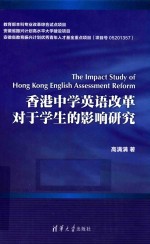

香港中学英语改革对于学生的影响研究 英文PDF电子书下载
- 电子书积分:12 积分如何计算积分?
- 作 者:高满满著
- 出 版 社:北京:清华大学出版社
- 出版年份:2015
- ISBN:9787302414131
- 页数:306 页
Chapter 1 Introduction 1
1.1 Origins of the Study 1
1.2 Rationale of the Study 2
1.3 Research Questions 4
1.4 Methodological Approach of This Study 5
1.5 Organization of the Book 6
Chapter 2 Hong Kong English Assessment Reform:Impact on Students'Attitudes and Anxiety 7
2.1 Overview 7
2.2 Testing and Assessment in Hong Kong 7
2.2.1 Hong Kong Testing and Assessment System 7
2.2.2 Examination Culture in Hong Kong 9
2.2.3 The Paradigm Shift of Assessment System in Hong Kong 11
2.3 Theoretical Rationale of the Assessment Reform 13
2.3.1 Assessment for Learning 13
2.3.2 Formative Use of Summative Assessment 18
2.3.3 Teacher-based Assessment 22
2.4 The Reform:School-based Assessment 24
2.4.1 The Development and Rationale of SBA 25
2.4.2 The Format of SBA 27
2.4.3 Problems and Difficulties Confronting SBA 30
2.4.4 Students in SBA 33
2.5 The Impact of Assessment on Students 34
2.5.1 Testing and Motivation for Learning 34
2.5.2 The Impact of Teacher-based Assessment on Students 36
2.6 Students'Attitudes Towards Assessment 39
2.6.1 Students'Voices 40
2.6.2 Students'Conceptions of Assessment 41
2.6.3 Assessment Attitudes of Hong Kong Students 44
2.7 Anxiety in Assessment 45
2.7.1 The Prevalence of Anxiety in Assessment 45
2.7.2 What is anxiety? 47
2.7.3 Anxiety:Positive or Negative? 50
2.8 Summary 53
Chapter 3 Research Design 55
3.1 Introduction 55
3.2 Mixed Methodology 55
3.2.1 Methodological Considerations 55
3.2.2 Pragmatism and Mixed Methods Research 59
3.2.3 Mixed Methods Research Typology 60
3.3 Stage One—The Pilot Case Study 64
3.3.1 Overview 64
3.3.2 Research Questions 64
3.3.3 Research Methods 64
3.3.4 Summary 66
3.4 Stage Two—Large-scale Questionnaire 67
3.4.1 Overview 67
3.4.2 Research Questions 67
3.4.3 Data Collection 67
3.4.4 Data Analysis 70
3.4.5 Summary 70
3.5 Stage Three—Case Study 71
3.5.1 Overview 71
3.5.2 Research Questions 71
3.5.3 Data Collection 72
3.5.4 Data Analysis 75
3.5.5 Summary 76
3.6 Ethics Concems 76
3.7 Trustworthiness 77
3.7.1 Triangulation 77
3.7.2 Member Checks 78
3.7.3 Reflections on My Role as a Researcher 78
3.8 Summary 80
Chapter 4 Stage One—Ethnographic Case Study 81
4.1 Overview 81
4.2 The School Context 82
4.3 Mediation of the Teacher 83
4.3.1 Teaching Belief 84
4.3.2 Mediation of SBA—Underlying Principles 85
4.3.3 Mediation of SBA—Practice 88
4.3.4 Summary 93
4.4 Students'Voices in SBA 93
4.4.1 What did students think of SBA? 93
4.4.2 How anxious were students about SBA? 103
4.5 Summary 110
4.5.1 Summary of Findings 110
4.5.2 Implications for Further Stages 112
Chapter 5 Stage Two—Large-Scale Questionnaire 115
5.1 Overview 115
5.2 Development of the Major Instrument 115
5.2.1 Development Procedure 116
5.2.2 The Instrument 117
5.2.3 Summary 122
5.3 Questionnaire Pilot 122
5.3.1 Descriptive Analysis 123
5.3.2 Reliability 125
5.3.3 Correlations 126
5.3.4 Summary 128
5.4 Results of the Main Study 129
5.4.1 Background Information 129
5.4.2 Descriptive Analysis of Major Variables 131
5.4.3 Reliability and Factor Analysis 140
5.4.4 Correlation 146
5.4.5 Group Differences 149
5.4.6 Multiple Regression Analyses 152
5.5 Summary of Findings 154
5.5.1 Students'Attitudes Towards SBA 154
5.5.2 Students'Anxiety About SBA 157
5.5.3 The Relationship Between Attitudes Towards and Anxiety About SBA 158
5.5.4 Implications for the Next Stage 159
Chapter 6 Stage Three—Case Study in School B 161
6.1 Overview 161
6.2 The School 161
6.3 Teacher's Mediation of SBA 163
6.3.1 Teacher's Mediation of SBA—Principles 163
6.3.2 Teacher's Mediation of SBA—Practice 165
6.4 Students'Attitudes Towards SBA 170
6.4.1 Accountability 170
6.4.2 Improvement 171
6.5 Students'Anxiety About SBA 174
6.5.1 The School 174
6.5.2 TheTeacher 175
6.5.3 Class Atmosphere 180
6.6 Students'Preparation for SBA 182
6.6.1 Self-preparation 183
6.6.2 Peer Cooperation and Rehearsal 184
6.7 Summary of Findings 187
Chapter 7 Stage Three—Case Study in School C 189
7.1 Overview 189
7.2 The School 189
7.3 Teacher's Mediation of SBA 191
7.3.1 Teacher's Mediation of SBA—Principles 191
7.3.2 Teacher's Mediation of SBA—Practice 194
7.4 Students'Attitudes Towards SBA 199
7.4.1 Accountability 199
7.4.2 Improvement 203
7.4.3 Enjoyment 205
7.5 Students'Anxiety About SBA 206
7.5.1 The School 207
7.5.2 The Teacher 208
7.5.3 Class Atmosphere 210
7.6 Students'Preparation for SBA 212
7.6.1 Self-preparation 212
7.6.2 Rehearsal with Teachers 213
7.6.3 Peer Cooperation 214
7.6.4 Tutorial School 216
7.7 Summary of Findings 218
Chapter 8 Synthesizing Quantitative and Qualitative Findings 221
8.1 Overview 221
8.2 What were students'attitudes towards SBA? 222
8.2.1 Improvement 222
8.2.2 Accountability 225
8.2.3 Enjoyment 229
8.2.4 Summary 230
8.3 To what extent did students experience anxiety in SBA? 232
8.3.1 Anxiety About SBA 232
8.3.2 The Relationship Between Students'Attitudes towards and Anxi-etyAbout SBA 236
8.3.3 Summary 238
8.4 How did the contextual conditions affect students'attitudes towards and anxiety about SBA? 240
8.4.1 SBA Context at the School Level 241
8.4.2 Teachers'Mediation of SBA 243
8.4.3 Summary 251
8.5 Summary 252
Chapter 9 Conclusion 253
9.1 Introduction 253
9.2 Students'Perspectives on SBA 253
9.3 Complexity of Assessment Impact 256
9.4 Implications 262
9.5 Limitations and Further Research 267
References 271
Appendix 1:The Questionnaire Used in Stage Two 288
Appendix 2:SBA Assessment Criteria 294
Appendix 3:SBA Assessment Record 299
Appendix 4:Factor Loadings for Items in Students'Attitudes Towards SBA 302
Appendix 5:Item-level Reliability Statistics 303
- 《高级英语阅读与听说教程》刘秀梅编著 2019
- 《思维导图 超好用英语单词书》(中国)王若琳 2019
- 《初中生英语作文 提高篇》清瑶主编 2019
- 《培生高级英语语法 练习册》培生教育 2019
- 《指向核心素养 北京十一学校名师教学设计 英语 七年级 上 配人教版》周志英总主编 2019
- 《365奇趣英语乐园 世界民间故事》爱思得图书国际企业 2018
- 《新课标背景下英语教学理论与教学活动研究》应丽君 2018
- 《幼儿英语游戏活动指导与实训》苏小菊,任晓琴主编;颜晓芳,覃静,谢恬恬,钟博维副主编 2020
- 《体育公共服务改革 理想之美与现实之殇》齐超 2019
- 《剑桥国际英语写作教程 段落写作》(美)吉尔·辛格尔顿(Jill Shingleton)编著 2019
- 《中风偏瘫 脑萎缩 痴呆 最新治疗原则与方法》孙作东著 2004
- 《水面舰艇编队作战运筹分析》谭安胜著 2009
- 《王蒙文集 新版 35 评点《红楼梦》 上》王蒙著 2020
- 《TED说话的力量 世界优秀演讲者的口才秘诀》(坦桑)阿卡什·P.卡里亚著 2019
- 《燕堂夜话》蒋忠和著 2019
- 《经久》静水边著 2019
- 《魔法销售台词》(美)埃尔默·惠勒著 2019
- 《微表情密码》(波)卡西亚·韦佐夫斯基,(波)帕特里克·韦佐夫斯基著 2019
- 《看书琐记与作文秘诀》鲁迅著 2019
- 《酒国》莫言著 2019
- 《大学计算机实验指导及习题解答》曹成志,宋长龙 2019
- 《指向核心素养 北京十一学校名师教学设计 英语 七年级 上 配人教版》周志英总主编 2019
- 《大学生心理健康与人生发展》王琳责任编辑;(中国)肖宇 2019
- 《大学英语四级考试全真试题 标准模拟 四级》汪开虎主编 2012
- 《大学英语教学的跨文化交际视角研究与创新发展》许丽云,刘枫,尚利明著 2020
- 《北京生态环境保护》《北京环境保护丛书》编委会编著 2018
- 《复旦大学新闻学院教授学术丛书 新闻实务随想录》刘海贵 2019
- 《大学英语综合教程 1》王佃春,骆敏主编 2015
- 《大学物理简明教程 下 第2版》施卫主编 2020
- 《指向核心素养 北京十一学校名师教学设计 英语 九年级 上 配人教版》周志英总主编 2019
